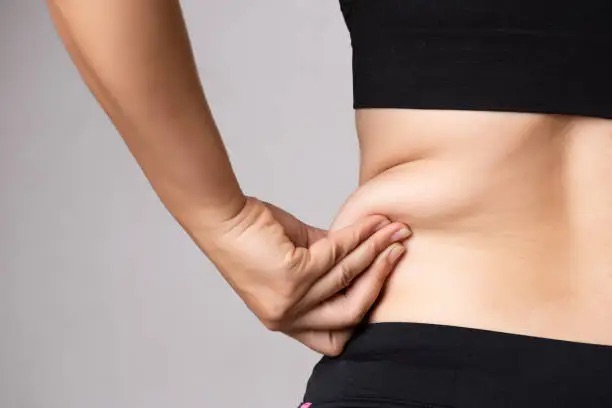Do you recall the days when Special K had a cereal commercial where they asked the question… “Can you pinch an inch”?
Since then, the U.S has had an explosion in the number of people becoming overweight and obese.
We know more and more about what to do to be healthy, and yet so many are not able to do what they know they should be doing in regard to their weight and their health. And that’s exactly why I coach clients on mindset and behavior change to help them get out of their own way…but I digress.
Though we may not like how we feel, carrying some extra weight is not always unhealthy.
The most common types of fat found in the body are visceral fat and subcutaneous fat.
Visceral fat is deeper and is found around your organs. Visceral fat is dangerous to your health. You can have visceral fat and not be obese.
Subcutaneous fat is the fat found under the skin and is the fat that leads to the dreaded “muffin top” or belly fat.
This is the fat that people have a hard time getting rid of.
Having a healthy, low processed food diet and getting in regular cardiovascular exercise is key to reducing subcutaneous body fat. Other major players in getting rid of this type of fat are enzymes and hormones.
Two enzymes that regulate flux in and out of fat cells are Lipoprotein Lipase (LPL) and Hormone Sensitive Lipase(HSL).
LPL is responsible for fat storage and HSL is responsible for fat release. The major hormones involved are insulin, cortisol and the fight or flight hormones epinephrine and norepinephrine.
Since insulin and cortisol produce the greatest negative impact on belly fat I will address them here.
To break it down to the simplest terms, think of insulin as the starch and sugar hormone and cortisol as the sleep and rest hormone.
The natural inclination when wanting to lose weight and the muffin top is to reduce all carbs. Reducing carbs is a better strategy than low fat eating for reducing belly fat. But low blood sugar stresses the body and raises cortisol levels, so you do not want to eat a diet too low in carbs either.
The best approach is to modify the starchy, processed foods. You should avoid the white refined carbs such as whites breads and rolls, chips, cakes and sugar overall for the most part. Get your fiber from complex carbohydrates and vegetables.
Complex carbohydrates will provide energy and stabilize blood sugar while at the same time lowering insulin slowly and keeping cortisol stable. To do this, choose carbohydrates with a low glycemic load and/or pair all complex carbs with some protein.
For example, a great snack would be an apple with a handful of almonds or 1 tbsp of natural nut butter. (I use Smuckers Natural Peanut Butter since it’s only peanuts and salt.) Studies show this also prevents weight regain.
Increasing protein intake has a favorable impact on belly fat and the muffin top as well. Protein gives your body a metabolic boost when digesting. Increasing protein has also been been shown to decrease the potential for weight regain.
So in layman’s terms, protein, vegetables and low glycemic carbs create a hunger suppressing, high volume punch with minimal insulin production.
Remember, insulin is a fat storing hormone. It is responsible for shoveling calories into fat tissue.
Sleep and stress management aid in lowering cortisol production.
And when it comes to belly fat, consuming alcohol also needs to be addressed.
Alcohol is calorie dense making it easier to have an excess caloric intake. Moreover, alcohol can raise cortisol levels leading to fat storage.
Alcohol is broken down to acetate which is the same end product that fat and sugar metabolism produce, and which the body sees no reason to burn and more reason to store. Therefore when it comes to belly fat, you may want to reconsider the number of cocktails you have in a weeks time.
If you want to learn how to combine meals and snacks that are low-glycemic carbs paired with protein, you can get my Lighten Up 21-Day Jumpstart Plan for Weight Loss including Meal Plan and Recipe Guide.
This low glycemic plan tells you exactly what to eat and how much to eat and even includes a shopping list.
It’s never too late to start to take better care of your health and your body. Slow and steady changes lead to slow and steady weight loss and reduction of belly fat which is exactly what you want.





